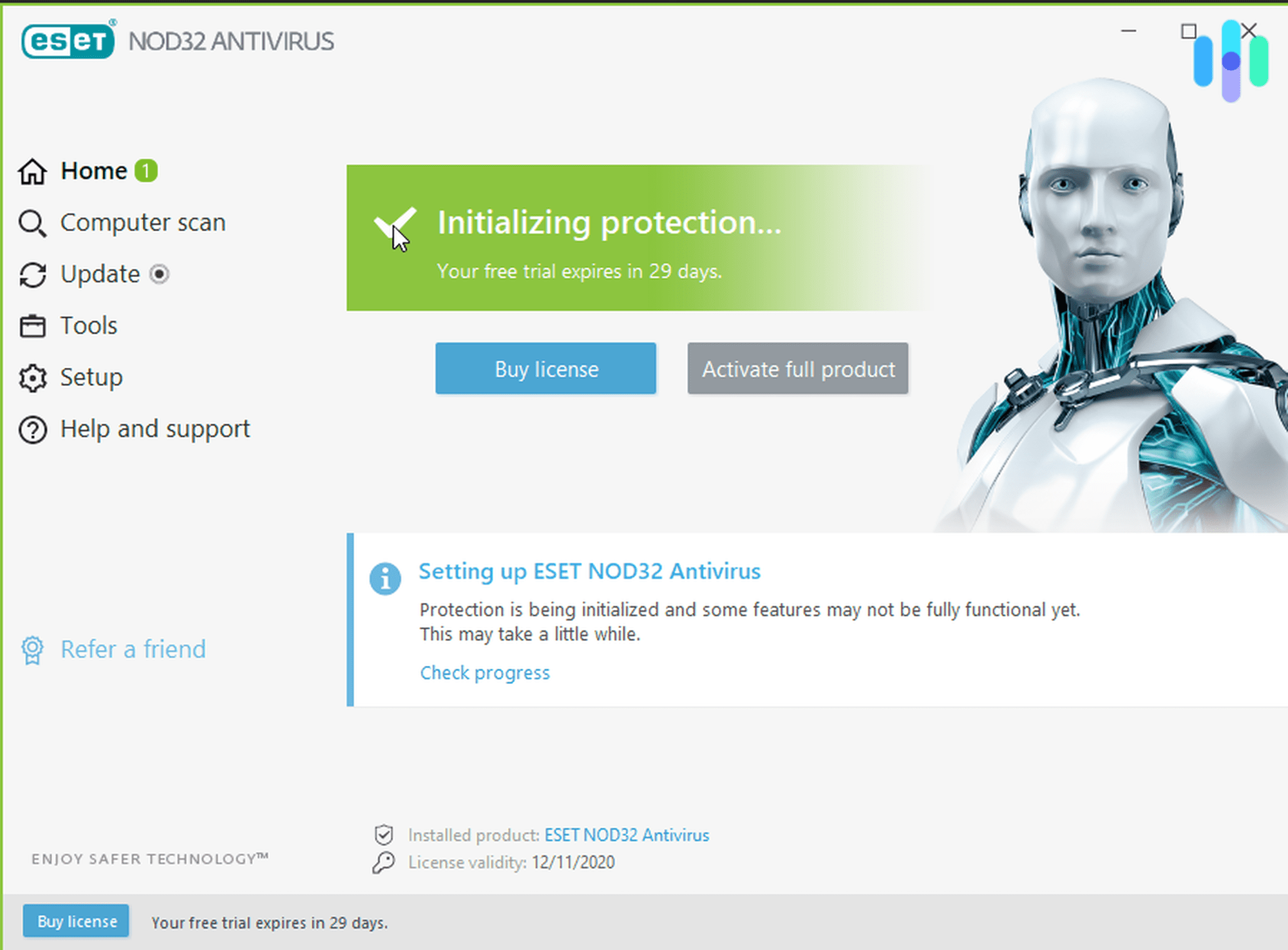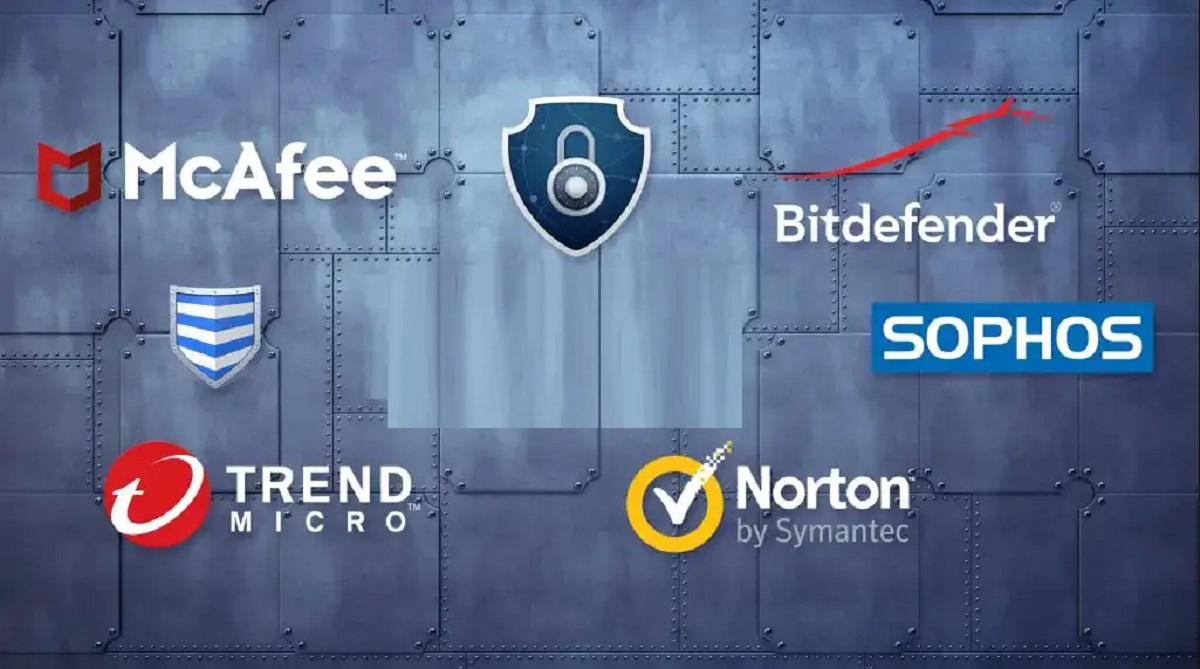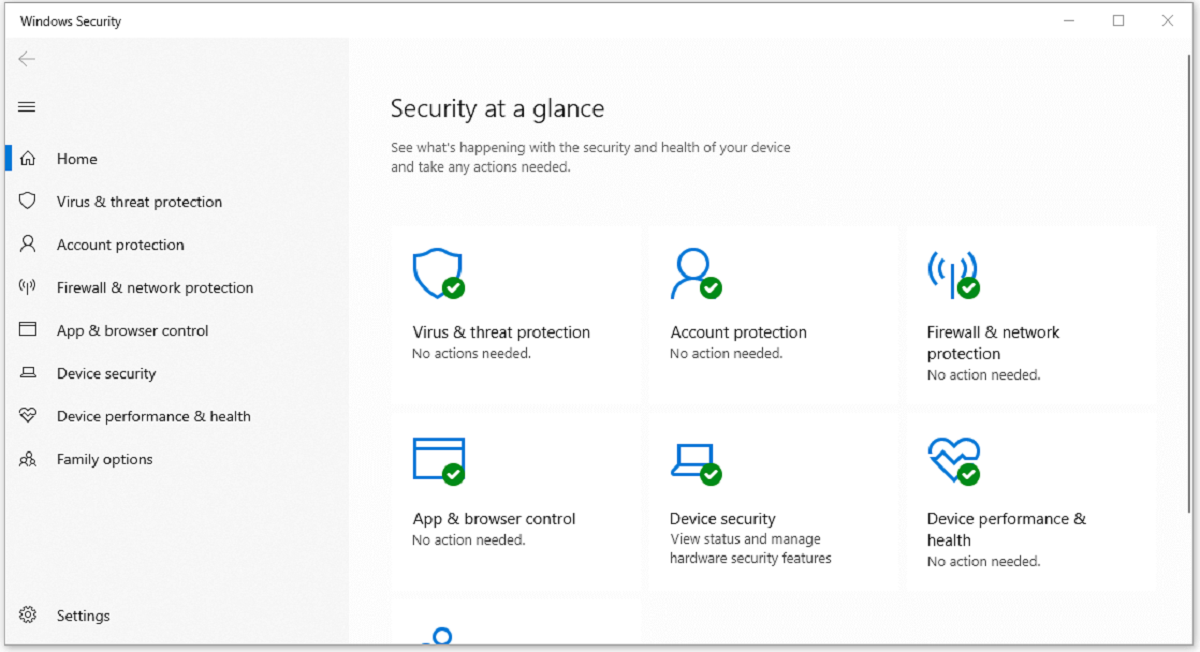Introduction
Antivirus software plays a crucial role in safeguarding our digital lives by protecting our devices from malware, viruses, and other online threats. With the increasing reliance on technology and the ever-evolving landscape of cyber attacks, having a reliable antivirus program is essential to maintain the security of our personal and sensitive information.
In today’s interconnected world, where we extensively use the internet for communication, shopping, banking, and entertainment, the threat of malware infections is more prevalent than ever. Antivirus software helps us combat these threats by detecting, preventing, and removing malicious software that can compromise the integrity and privacy of our data.
While most of us are familiar with the term “antivirus,” how exactly does this software work? In this article, we will delve into the inner workings of antivirus software to gain a better understanding of its mechanisms and techniques.
The primary objective of antivirus software is to proactively identify and eliminate malware infections on our devices. It achieves this by employing different scanning methods, detection algorithms, and security features. By continuously monitoring system activities and files, an antivirus program can effectively detect and neutralize threats before they can cause harm.
Throughout this article, we will explore the various components and functionalities of antivirus software, such as real-time protection, quarantine, signature-based detection, heuristic analysis, behavior monitoring, and cloud-based scanning. By the end, we will have a comprehensive understanding of how antivirus software works and why it is an essential tool in today’s digital landscape.
Understanding Antivirus Software
Antivirus software is designed to detect, prevent, and remove malicious software, including viruses, malware, ransomware, and spyware from our computer systems. It serves as a shield against cyber threats, offering a layer of protection to ensure the safety of our data and privacy.
When you install antivirus software on your device, it starts by scanning files, programs, and documents for any signs of malware. It uses various detection methods, including signature-based detection, heuristic analysis, and behavior monitoring, to identify and classify potential threats.
One of the primary functions of antivirus software is to use signature-based detection. This method involves comparing files on your system to a vast database of known malware signatures. If a file matches a signature, it is flagged as potentially harmful and subjected to further examination or action. Signature-based detection is effective for detecting known malware, but it may struggle to identify new, previously unseen threats.
In addition to signature-based detection, antivirus software also employs heuristic analysis. This technique allows the software to identify suspicious patterns or behaviors that indicate the presence of malware. Heuristic analysis goes beyond relying on specific signatures and uses intelligent algorithms to detect and protect against unknown threats.
Behavior monitoring is another crucial aspect of antivirus software. It involves observing the behavior of programs and processes running on your system. If a program exhibits suspicious activities, such as attempting to modify system files or accessing sensitive information, the antivirus software will intervene and either block the action or alert the user for further action.
Furthermore, some antivirus software also utilizes cloud-based scanning. In this approach, the software offloads some of the scanning processes to remote servers on the internet. This allows for faster and more efficient scanning, as the burden of processing is shared between your device and the cloud servers. Cloud-based scanning also enables real-time synchronization of threat intelligence, ensuring that your antivirus software is always up to date with the latest malware signatures and detection techniques.
By understanding the fundamentals of antivirus software, you can appreciate the importance of maintaining an up-to-date and reliable antivirus solution on your devices. These programs constantly adapt and evolve to keep up with the ever-changing landscape of cyber threats, providing you with peace of mind that your digital world remains protected.
The Basics of Antivirus Scanning
Antivirus scanning is the foundational aspect of antivirus software. It involves examining files, programs, and other elements on your device to identify any malicious content. The scanning process is crucial for detecting and removing threats that could potentially harm your computer system.
There are two primary types of scans performed by antivirus software: on-demand scans and real-time scans.
On-demand scans, also known as manual scans, are initiated by the user. You can run these scans at any time to scan specific files or folders, or even your entire system. On-demand scanning is particularly useful when you suspect a specific file or area of your device may be infected with malware.
Real-time scans, on the other hand, provide continuous, automatic protection. This type of scanning occurs in the background while you use your device, constantly monitoring files and activities. Real-time scanning ensures that any potential threats are quickly identified and neutralized, preventing them from causing harm to your system.
During the scanning process, antivirus software employs various techniques and algorithms to identify and classify potential threats. One of the most commonly used methods is signature-based detection. In this approach, the antivirus software compares the files being scanned against a vast database of known malware signatures. If a file matches any of the signatures, it is flagged as potentially malicious and subjected to further examination.
Another scanning technique used by antivirus software is heuristic analysis. This method involves analyzing the behavior and characteristics of files to identify suspicious patterns or activities. By using intelligent algorithms, antivirus software can detect previously unseen malware that might not have a known signature.
To ensure that scanning is thorough and comprehensive, antivirus software typically employs multiple scanning levels. The software scans not only the file contents but also the file system structures, metadata, and even the boot sectors of your device. This multi-layered approach maximizes the chances of detecting and preventing any hidden or deeply buried threats.
Antivirus scanning can be resource-intensive, especially when performing full system scans or scanning large files. To minimize the impact on system performance, antivirus software utilizes various optimization techniques. This includes using caching mechanisms to remember previously scanned files, prioritizing critical system files, and employing intelligent scanning algorithms that focus on high-risk areas first.
By understanding the basics of antivirus scanning, you can appreciate how antivirus software actively works to protect your device from potential threats. Whether it’s through on-demand scans or real-time scanning, antivirus software ensures that your digital environment remains secure and free from malware.
Real-time Protection and Background Scanning
Real-time protection and background scanning are key features of antivirus software that provide continuous monitoring and proactive defense against malware threats. These features work together to ensure that your device remains protected even during your everyday usage.
Real-time protection, also known as real-time scanning or on-access scanning, is a fundamental component of antivirus software. It actively monitors your device and scans files, programs, and web traffic in real-time as you access them. This constant surveillance allows the antivirus software to detect and neutralize threats before they can cause any harm.
When you open or download a file, real-time protection immediately scans it to check for any signs of malware. If any malicious content is detected, the antivirus software takes immediate action to quarantine or remove the threat. This proactive approach ensures that potential threats are tackled as soon as they are encountered, protecting your device and data from being compromised.
Background scanning is another essential aspect of real-time protection. While you use your device, background scanning operates discreetly in the background, continuously scanning files, processes, and system activities. It allows the antivirus software to detect any suspicious behavior or signs of malware without interrupting your regular tasks.
The advantage of background scanning is that it provides continuous protection without requiring explicit user intervention. It constantly evaluates the security of your system, keeping an eye on any potential threats that may attempt to infiltrate your device. This feature is particularly valuable as it protects against threats that may try to exploit vulnerabilities in real-time.
Real-time protection and background scanning leverage various techniques to ensure comprehensive security. For example, the software uses signature-based detection to compare files and processes against a database of known malware signatures. It also employs heuristic analysis to detect previously unseen threats based on suspicious behaviors or characteristics.
In addition to scans initiated by user activities, real-time protection and background scanning also monitor your web browsing. They inspect websites for potentially harmful content, block access to malicious websites, and warn you about phishing attempts or suspicious downloads. This layer of protection adds an extra line of defense against online threats.
To optimize performance and minimize resource usage, antivirus software often employs intelligent scanning. This means that it focuses on high-risk areas, such as system files and locations commonly targeted by malware, while scanning in the background. By prioritizing critical areas, the software ensures efficient protection without impacting system performance.
Real-time protection and background scanning work seamlessly together to provide continuous protection against malware threats. By leveraging various scanning techniques and monitoring activities, antivirus software keeps your device safe from potential threats while allowing you to use your device without interruption or compromise.
Quarantine and Removal
When antivirus software detects a potential threat on your device, it takes immediate action to neutralize and eliminate the malicious content. This is where the processes of quarantine and removal come into play, ensuring that identified threats are safely dealt with and eliminated from your system.
Quarantine is a protective measure used by antivirus software to isolate suspicious or infected files. When a file is flagged as potentially harmful, it is moved to a secure quarantine area where it cannot cause any further harm. By isolating the file, the antivirus software prevents it from executing or infecting other files on your system.
Quarantine serves two important purposes. Firstly, it prevents any potential damage the infected file could cause, ensuring that your system remains secure. Secondly, it allows antivirus software to further analyze the file and determine if it is indeed malware or a false positive. If the file is determined to be harmless, it can be safely restored to its original location.
During the quarantine process, antivirus software may also perform additional actions, such as renaming the file or modifying its permissions to prevent accidental execution. This further reduces the chances of the file causing harm while it is under investigation.
Once the antivirus software confirms that a file is indeed malware, it proceeds with the removal process. The removal process involves permanently deleting the malicious file from your system. By removing the threat, the antivirus software ensures that it cannot cause any further damage or infect other files.
It is important to note that antivirus software generally provides the option for users to review files in quarantine before removing them permanently. This gives you the opportunity to double-check if any false positives were flagged and restore legitimate files if necessary.
In some cases, antivirus software may not be able to completely remove certain infections, especially if they have deeply rooted themselves in the system. In such instances, the software may provide recommendations on additional steps you can take to fully eradicate the threat, such as using specialized removal tools or seeking expert assistance.
The quarantine and removal processes ensure that identified threats are effectively dealt with, protecting your system from the harmful effects of malware. By isolating and removing malware, antivirus software restores the integrity and security of your device, allowing you to use it without the risk of further infections or compromises.
Signature-based Detection
Signature-based detection is a widely used technique employed by antivirus software to identify and classify known malware. It works by comparing files and programs on your device with a database of pre-defined malware signatures.
Each malware signature is a unique identifier that represents a specific pattern or characteristic of a known malicious file or code. These signatures are created based on the analysis of existing malware samples. When an antivirus software scans a file, it calculates the hash value of the file and compares it against the signatures in its database.
If a file matches any of the signatures in the database, it is flagged as potentially harmful or infected. The antivirus software can then take appropriate action, such as quarantining the file or initiating the removal process. Signature-based detection is highly effective in identifying and eliminating known malware threats.
One of the advantages of signature-based detection is its accuracy in identifying already known malware with a high degree of certainty. This method can quickly identify and neutralize threats that have been previously analyzed and added to the database of signatures.
However, signature-based detection does have its limitations. It relies on the antivirus software having an up-to-date signature database in order to identify the latest malware. To combat this, updates containing new malware signatures are regularly released by antivirus vendors to keep the software current.
One drawback of signature-based detection is its inability to detect new and unknown malware. Since the database only contains signatures for known malware, signature-based detection may not be effective in identifying previously unseen threats or malware variants with slight modifications.
Malware authors are constantly evolving their techniques to evade signature-based detection. They may use methods such as polymorphism or packing, which alter the characteristics of the malware and make it more difficult for antivirus software to match the signatures.
To address the limitations of signature-based detection, antivirus software incorporates other detection methods, such as heuristic analysis and behavior monitoring. These complementary techniques allow antivirus software to detect and neutralize emerging threats that may not have known signatures.
Despite its limitations, signature-based detection remains an integral part of antivirus software. It provides efficient and accurate detection and removal of known malware, ensuring that devices are protected against the widespread and well-documented threats in circulation.
By continuously updating and expanding their signature databases, antivirus vendors strive to keep up with the ever-growing pool of known malware variants, bolstering their software’s ability to recognize and eliminate malicious threats.
Heuristic Analysis
Heuristic analysis is a proactive method employed by antivirus software to detect and identify new and unknown malware. Unlike signature-based detection, which relies on pre-defined malware signatures, heuristic analysis uses intelligent algorithms to analyze the behavior and characteristics of files and programs.
When a file is scanned using heuristic analysis, the antivirus software evaluates various attributes such as file structure, code patterns, and behavior to determine if it exhibits any suspicious or potentially malicious traits. By applying a set of predefined rules, the software can identify files that deviate from typical benign behaviors.
One of the key advantages of heuristic analysis is its ability to detect previously unseen malware and variants. This is especially useful in identifying zero-day threats, which are newly discovered vulnerabilities that cybercriminals exploit before a patch is available.
Heuristic analysis helps antivirus software stay proactive in detecting new threats as it does not rely on known signatures. The intelligent algorithms can recognize behavior patterns that are typically associated with malware, allowing the software to take prompt action before the threat can cause any damage.
However, heuristic analysis has its limitations as well. It can produce false positives, flagging legitimate files as potentially malicious due to similarities in behavior. To minimize false positives, antivirus software developers continuously refine and update their algorithms to improve accuracy.
The effectiveness of heuristic analysis depends on the quality and sophistication of the algorithms implemented in the antivirus software. The algorithms need to strike a balance between identifying genuine threats and avoiding false positives.
To enhance the capabilities of heuristic analysis, some antivirus software incorporates machine learning techniques. By training the software on large datasets, it can learn to recognize patterns and behaviors associated with malware more accurately over time.
As cyber threats evolve and become more sophisticated, antivirus vendors continuously update their heuristic analysis algorithms to keep up with emerging threats. They leverage threat intelligence gathered from various sources to refine the algorithms and improve the software’s ability to detect new and unknown malware.
Heuristic analysis is a crucial component of antivirus software, allowing it to stay ahead of rapidly evolving malware threats. By proactively analyzing file structures, behaviors, and characteristics, antivirus software can identify and neutralize potential threats, providing an additional layer of defense against unknown and emerging malware.
Behavior Monitoring
Behavior monitoring is a proactive security feature employed by antivirus software to detect and respond to suspicious activities on your device. Rather than relying solely on signatures or file attributes, behavior monitoring focuses on observing the behavior and actions of programs and processes in real-time.
Antivirus software with behavior monitoring capabilities constantly monitors the activities of running programs and processes, looking for any signs of malicious behavior. This includes actions such as attempting to modify critical system files or accessing sensitive data without authorization.
By analyzing the behavior of programs, behavior monitoring can detect previously unseen threats and zero-day exploits that might not have known signatures or patterns. It can identify malware that may have evaded traditional signature-based detection or heuristic analysis.
This security measure works by establishing a baseline of normal behavior for each program and process on your device. Any abnormal actions or deviations from this baseline are flagged as potentially harmful. For example, if a program suddenly starts encrypting files or making unauthorized network connections, behavior monitoring would raise an alarm.
When suspicious behavior is detected, antivirus software equipped with behavior monitoring can take immediate action to protect your system. This may include blocking the program’s activity, quarantining the file, or displaying a warning to the user to investigate further.
Behavior monitoring is particularly effective in detecting new or zero-day malware that exhibit unusual or malicious behavior, as these threats may escape traditional detection methods. It provides an additional layer of security by detecting and stopping potential threats before they can cause harm to your device or compromise your data.
However, behavior monitoring does have its limitations. It relies on the antivirus software’s ability to accurately determine what constitutes normal or malicious behavior. In some cases, legitimate programs or activities might be mistakenly flagged as suspicious, leading to false positives. Antivirus vendors continuously refine their behavior monitoring algorithms to minimize false positives and improve accuracy.
Additionally, behavior monitoring requires a degree of system resources in order to continuously monitor and analyze program activities. Therefore, there may be a slight impact on performance, especially during intensive tasks or on devices with limited resources.
To enhance the effectiveness of behavior monitoring, some antivirus software incorporates machine learning and artificial intelligence techniques. By analyzing large datasets of known good and malicious behaviors, the software can improve its ability to accurately detect and respond to suspicious activities.
Behavior monitoring is an essential feature of antivirus software that adds an extra layer of protection against advanced and emerging threats. By actively monitoring and analyzing the behavior of programs and processes on your device, antivirus software with behavior monitoring capabilities can detect and block potential threats in real-time, ensuring the security of your system and data.
Cloud-based Scanning
Cloud-based scanning is a valuable feature offered by many antivirus software solutions that offload some of the scanning processes to remote servers on the Internet, also known as the cloud. This approach enhances the efficiency and effectiveness of antivirus scanning, providing faster and more reliable protection for your devices.
Traditional antivirus scanning relies solely on the processing power and resources of your local device. While this method is effective, it can be resource-intensive and may impact system performance, especially when scanning large files or performing comprehensive system scans.
Cloud-based scanning addresses this limitation by leveraging the computing power of remote servers. When you initiate a scan or encounter a potentially malicious file, your antivirus software sends the file or relevant information to the cloud servers for analysis. These powerful servers can perform the scanning and analysis much faster and more efficiently than your local device.
One of the key advantages of cloud-based scanning is its ability to provide real-time protection and quick response to emerging threats. The cloud servers receive continuous updates from the antivirus vendors, ensuring that they have the latest malware definitions and detection techniques. This means that your antivirus software can stay up to date with the most recent threats, even if you haven’t performed recent updates on your local device.
Another benefit of cloud-based scanning is its scalability. Cloud servers have ample resources, allowing them to handle a higher volume of scans and detection tasks. This makes it possible to scan large files, perform extensive system scans, or handle multiple scans simultaneously without significantly impacting your device’s performance.
Cloud-based scanning also facilitates the sharing of threat intelligence between devices and users. When a new threat is detected and analyzed in the cloud, that information can be quickly disseminated to all connected devices, providing a broader network of protection against emerging threats.
There are, however, some considerations to keep in mind with cloud-based scanning. Privacy concerns may arise as files are sent to remote servers for analysis. To address this, reputable antivirus vendors ensure that the data transmitted to the cloud is encrypted and anonymized to protect user privacy.
Furthermore, cloud-based scanning requires an active internet connection for the scanning process. Without a stable internet connection, the full benefits of cloud-based scanning may not be realized.
Overall, cloud-based scanning enhances the efficiency, scalability, and effectiveness of antivirus scanning. By leveraging remote servers and the power of the cloud, antivirus software can provide real-time protection, swift response to emerging threats, and robust scanning capabilities, ensuring the security of your devices and data.
Conclusion
Antivirus software is an essential tool in maintaining the security and integrity of our digital lives. It plays a crucial role in detecting, preventing, and removing malware, viruses, and other online threats. Throughout this article, we have explored the inner workings and features of antivirus software, gaining a better understanding of how it protects our devices and data.
We began by discussing the importance of antivirus software in today’s interconnected world and how it safeguards our personal and sensitive information. We then delved into the various components and functionalities of antivirus software, such as real-time protection, quarantine and removal, signature-based detection, heuristic analysis, behavior monitoring, and cloud-based scanning.
Real-time protection and background scanning provide continuous monitoring and proactive defense against malware threats. These features detect and neutralize potential threats in real-time, ensuring that our devices are safeguarded during everyday usage.
Quarantine and removal are vital processes that securely isolate and eliminate malicious content identified by the antivirus software. By isolating infected files, antivirus software prevents any potential damage they could cause and allows for further analysis before taking appropriate action.
Signature-based detection, one of the most commonly used techniques, compares files against a database of known malware signatures. This method is effective in identifying and removing known threats but may struggle with new and unknown threats.
Heuristic analysis takes a proactive approach by analyzing the behavior and characteristics of files to identify suspicious patterns or activities. This technique helps detect new and previously unseen malware, enhancing the antivirus software’s ability to protect against emerging threats.
Behavior monitoring monitors the activities of programs and processes, raising an alarm when it detects suspicious or potentially malicious behaviors. This feature adds an extra layer of defense against advanced and emerging threats.
Cloud-based scanning leverages the power of remote servers to offload scanning processes, providing faster and more efficient scanning capabilities. It ensures real-time protection, quick response to emerging threats, and scalability to handle high volumes of scanning tasks.
In conclusion, antivirus software combines various techniques and features to protect our devices from malware and other online threats. By understanding how antivirus software works and the benefits it provides, we can make informed decisions when selecting and using antivirus software to ensure the security of our digital lives.

























